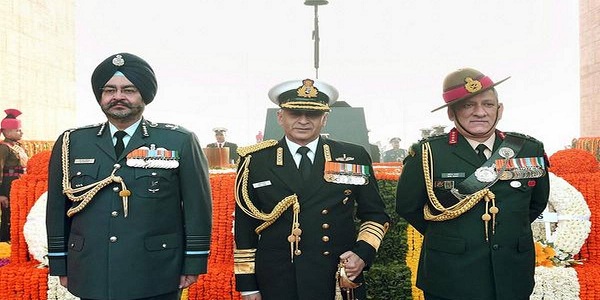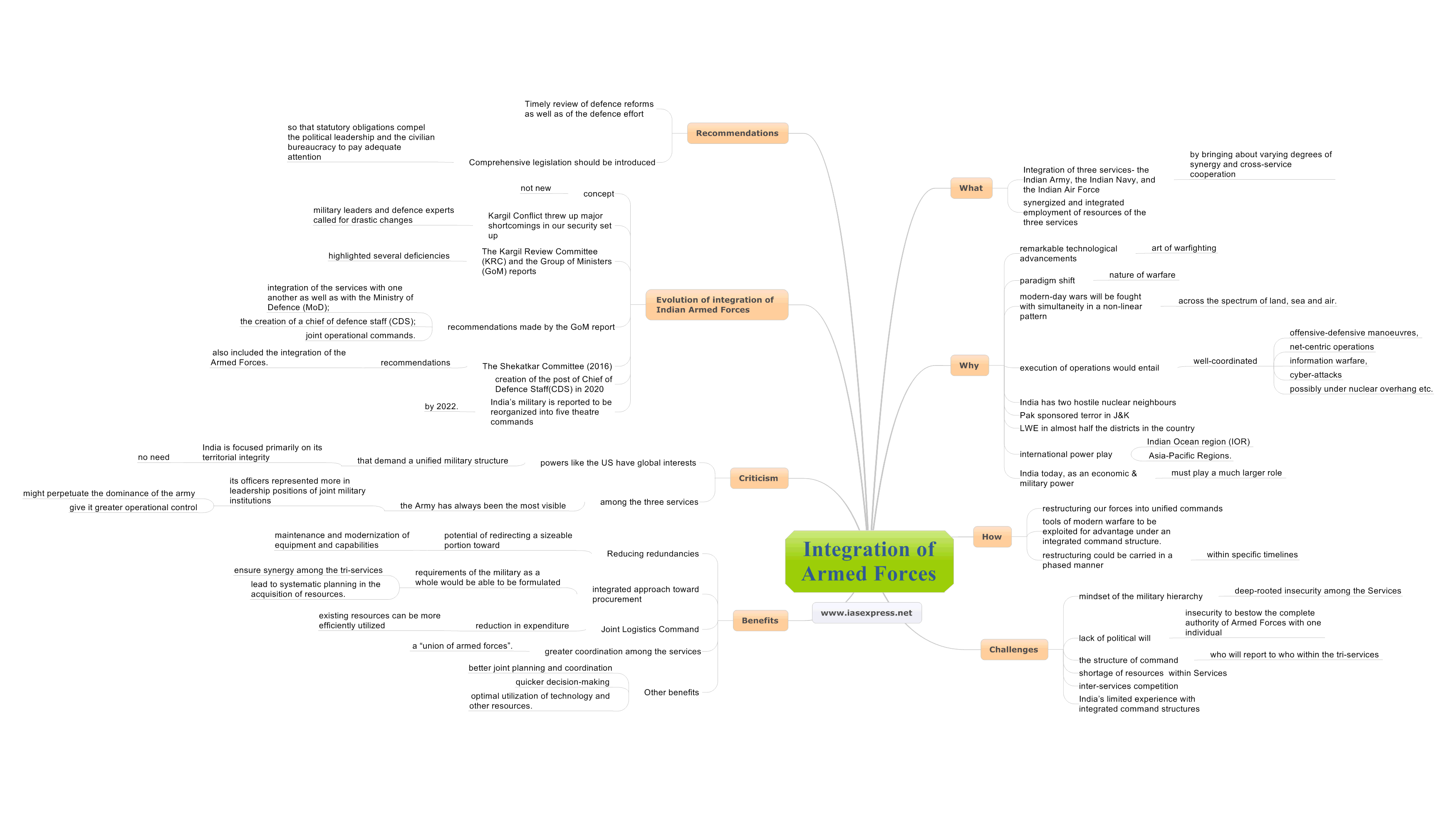Integration of Armed Forces – Benefits, Challenges and Way Forward

In a recent address, the Chief of Defence Staff(CDS), General Bipin Rawat replying to a question on the challenges being faced in the creation of the proposed theatre commands of the Indian armed forces said that integration and jointness among the three services are important for the country to face future security challenges. The address brings to the fore one of the most important burning issues on Indian military reforms. Integrating the armed forces is considered to be one of the essential needs for the Indian defence system. To prepare India to thrive in the changing global scenario, it will be important how India adopts new changes and how it utilises the capabilities of its defence staff. Integrating them will be one of the vital steps taken forward.
What does integration of Armed Forces mean?
The Indian Armed Forces comprise three divisions – the Indian Army, the Indian Navy, and the Indian Air Force. Integration of these three services by bringing about varying degrees of synergy and cross-service cooperation between the military wings is what is implied by the integration of armed forces. In other words, jointness implies synergized and integrated employment of resources of the three services to achieve the desired results in the least possible time. The primary aim is to avoid duplication of effort, ensure seamless integration and optimum employment of available resources
Why is the need to integrate Armed Forces?
- The remarkable technological advancements in science and technology in the 20th century have revolutionized the art of warfighting.
- The nature of warfare itself has witnessed a paradigm shift in the planning and execution of operations.
- The modern concept of warfighting relies on the tenets of real-time battlefield transparency 24 x 7, swift all-weather mobility under all battlefield conditions and immense lethality of firepower independent of range limitations.
- The modern-day wars will be fought with simultaneity in a non-linear pattern across the spectrum of land, sea and air.
- The execution of operations would entail well-coordinated offensive-defensive manoeuvres, net-centric operations, information warfare, cyber-attacks, possibly under nuclear overhang etc.
- India has two hostile nuclear neighbours. Additionally, India’s security threats include Pak sponsored terror in J&K as part of an instrument of state power, Left Wing Extremism (LWE) in almost half the districts in the country and international power play unfolding in the Indian Ocean region (IOR) as well as Asia-Pacific Regions.
- India today, as an economic & military power, must play a much larger role in the evolving geo-strategic environment in the region, particularly in the maritime domain.
- In such a complex operational environment, militaries have little option but to adopt methods of integrated warfighting.
- To effectively counter the list of security challenges, India will have to integrate the Armed Forces.
How to integrate the Armed Forces?
- This could be achieved only through restructuring our forces into unified commands. An integrated system aims to put all resources of the three services at the disposal of a theatre commander who will carry out the task in consonance with the legislated overall national aim.
- The tools of modern warfare; combat forces, air assets, surveillance assets, cyber systems, space-based weapons, etc can be best be exploited for advantage under an integrated command structure.
- The recommended unified commands could be additional functional commands, joint logistics command, cyber warfare command, geographical theatre commands and others.
- The restructuring could be carried in a phased manner within specific timelines.
What are the challenges in integration?
- The very first challenge is the mindset of the military hierarchy. There is deep-rooted insecurity among the Services, arising out of loss of absolute authority over its Service, loss of identity of each Service in an integrated set up and erosion of empire within each Service. This may lead to an unwillingness among the Armed Forces to integrate.
- Secondly, the lack of political will despite being convinced about the requirement of integration of the Armed Forces. There is a sense of reluctance arising out of insecurity to bestow the complete authority of Armed Forces with one individual.
- Thirdly, the structure of command, i.e. who will report to who within the tri-services and joint theatre command configurations, and who will have operational command over personnel and machinery, service chiefs or theatre commanders.
- Fourthly, shortage of resources within the Indian Air Force (IAF) which has only 31 operational squadrons against a modest sanctioned strength of 42, would make it difficult for the IAF to permanently station assets in a particular command with territorial boundaries.
- The fifth challenge is the inter-services competition wherein each service zealously oversees its own assets and strives for a greater share of the defence budget and influence might prove to be an obstacle in creating synergy among the services.
- Last but not the least, India’s limited experience with integrated command structures may require a fair bit of mid-course corrections which would require problems to be timely identified and remedied, and slow down the integration process regardless.
Benefits
- A huge amount of government expenditure is spent on payment salaries and allowances. Reducing redundancies across the services by integrating manpower within theatre commands has the potential of redirecting a sizeable portion toward maintenance and modernization of equipment and capabilities.
- With an integrated approach toward procurement, sans capital acquisitions, the requirements of the military as a whole would be able to be formulated. This, in turn, would ensure synergy among the tri-services, lead to systematic planning in the acquisition of resources.
- Integration of logistics by the formation of a Joint Logistics Command can help in reduction in expenditure and the existing resources can be more efficiently utilized.
- More efficient utilization of resources, greater coordination among the services, and more accurate and coordinated logistics planning.
- The Indian Armed Forces would not act as individual services rather they would act as a “union of armed forces”.
- Other benefits include better joint planning and coordination, quicker decision-making based on appropriate advice from specialists, and the optimal utilization of technology and other resources.
Criticism
- Critics often point out that powers like the US have global interests that demand a unified military structure, whereas India is focused primarily on its territorial integrity, there is no need for the integrated theatre command system.
- The fact that among the three services, the Army has always been the most visible and its officers represented more in leadership positions of joint military institutions might perpetuate the dominance of the army and give it greater operational control.
Evolution of integration of Indian Armed Forces
- The concept of ‘unified command in the Indian Armed Forces’ is not new.
- Kargil Conflict threw up major shortcomings in our security set up, military leaders and defence experts called for drastic changes to the existing system.
- The Kargil Review Committee (KRC) and the Group of Ministers (GoM) reports highlighted several deficiencies in India’s security management system and recommended certain measures to be undertaken.
- Of all the recommendations made by the GoM report, the three most important are; integration of the services with one another as well as with the Ministry of Defence (MoD); the creation of a chief of defence staff (CDS); and joint operational commands.
- The Shekatkar Committee (2016) recommendations also included the integration of the Armed Forces.
- The creation of the post of Chief of Defence Staff(CDS) in 2020 seems to be a major push in this direction.
- India’s military is reported to be reorganized into five theatre commands by 2022.
Recommendations
- Timely review of defence reforms as well as of the defence effort should be carried out by the Parliamentary Standing Committee on Defence to monitor the progress achieved and make further recommendations for improvement of the defence effort.
- Comprehensive legislation should be introduced so that statutory obligations compel the political leadership and the civilian bureaucracy to pay adequate attention to the defence effort in a time-bound manner besides “forcing” the three Services to become more “joint and integrated”.
Conclusion
As India is emerging rapidly from being a regional to a global power India must fulfil its security obligations. Jointness and integration will be a major step in this direction. Unified Commands would enable better joint planning and coordination, quicker decision-making based on appropriate advice from specialists, and the optimal utilization of technology and other resources. It is time that the attitudinal challenges are overcome and a top-down approach is adopted so that national security and national interests are not compromised.
Practise question
- Discuss major challenges in the integration of the Indian Armed Forces.
If you like this post, please share your feedback in the comments section below so that we will upload more posts like this.


